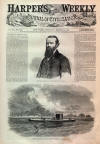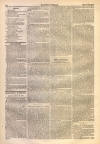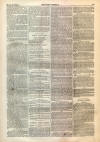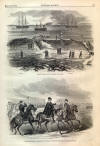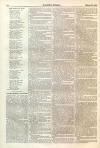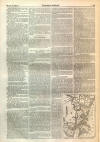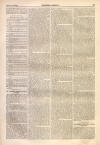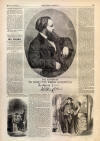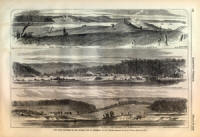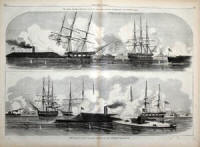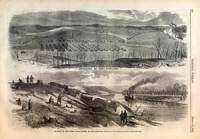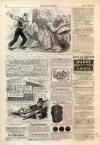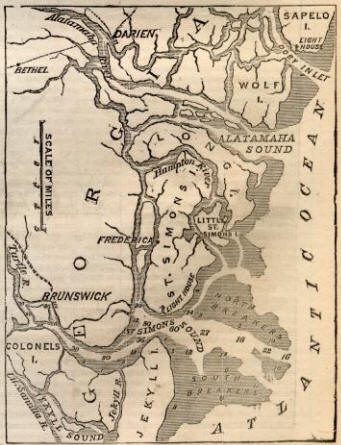|
This Site:
Civil War
Civil War Overview
Civil War 1861
Civil War 1862
Civil War 1863
Civil War 1864
Civil War 1865
Civil War Battles
Confederate Generals
Union Generals
Confederate History
Robert E. Lee
Civil War Medicine
Lincoln Assassination
Slavery
Site Search
Civil War Links
Civil War Art
Mexican War
Republic of Texas
Indians
Winslow Homer
Thomas Nast
Mathew Brady
Western Art
Civil War Gifts
Robert E. Lee Portrait
|
"Well," she exclaims at length, a
little quickly, "how long is this imprisonment to last? When will the commodity
be at liberty?"
"When victory is proclaimed, dear
Miss Josephine!"
She laughs, and then, "What a
provoking snarl, and all for a little jet ring!"
"Yes, all for a little jet
ring—all this delay and ruin perhaps to the whole fabric, for this contraband—a
jet ring, truly!"
The sudden bitterness of his tone
gave added weight to his words. She understood something of his meaning, not
wholly yet. She understood the play, the jesting correspondences of figure and
fact. And she says,
"So you think the war rests
there?"
"Yes, I think the war rests
there. I think it rests at the door of abolition agitation. And I think we shall
never know peace or union until that senseless meddling cry shall cease. Let
slavery alone, and it will take care of itself, and work out its own salvation
by some natural laws."
Snap went the slender thread-lost
all the labor of the night. The smooth, soft skein was a snarl again. A snarl
that even the skillful patience of Livingston Raynal would fail to untangle.
Drawing back, dropping off the
cotton from her hands, she says quickly, "Which natural laws, I suppose you to
mean, are servile insurrections."
For a moment her listener was
struck dumb with amaze. This fair little Josephine, the gay belle of ball and
fete. This fairy in countless flounces and fluttering ribbons to have an opinion
beyond her own gay world! The something akin to that stanch old republican,
Commodore Carey, was rising now to the surface. "Flattery and power and
position" were sinking out of sight.
And while he wonders, she goes
on:
"How can you say the war rests
there—how can you put this selfish rebellion on that ground—when, as early as
1776, John Adams wrote to his friend Gates—'All our misfortunes arise from a
single source—the resistance of the Southern colonies to a Republican
Government.' No, it is not abolitionism; it is slavery that has brought it on.
You might as well say that the protecting law of a Christian land, which dooms
the murderer to death, is the sole cause of his fate. And so you put up this
subterfuge when it is the old vantage-ground of baron and serf, noble and slave.
And if we keep a base silence we may have peace, you say. Peace! do not talk of
peace on such a servile silence as this!"
Stopping a moment, all flushed
and eager, she leaned forward, and from a table took a volume of Mrs.
Browning—the Casa Guidi. With gathering color and ardent voice she read-
"I love no peace which is not
fellowship,
And which includes not mercy. I
would have Rather the raking of the guns across
The world, and shrieks against
Heaven's architrave, Rather the struggle in the slippery fosse,
Of dying men and horses, and the
wave
Blood-bubbling....Enough said!—By
Christ's own cross, And by the faint heart of my womanhood,
Such things are better than a
Peace which sits Beside the hearth in self-commended mood,
And takes no thought how wind and
rain by fits Are howling out of doors against the good
Of the poor wanderer. What! your
peace admits
Of outside anguish while it sits
at home?
I loathe to take its name upon my
tongue-
It is no peace. 'Tis treason,
stiff with doom—
'Tis gagged despair, and
inarticulate wrong.
O Lord of Peace, who art Lord of
Righteousness, Constrain the anguished worlds from sin and grief, Pierce them
with conscience, purge them with redress, And give us peace which is no
counterfeit!"
Well might her listener be
amazed. He little suspected this underlying of will and strength—this outburst,
which showed clear sympathy for a cause, and clear knowledge of its points.
They had been treading on flowers
until now—a sudden step, the flowers are scattered; and on heroic battle ground
he is challenged and charged by one who, a moment since, smiled under Flora's
most peaceful garland.
Challenged and charged! Does he
accept the challenge? Does he charge back again with quivering lance?
No; a few light words of evasion,
a polite air of tolerance because it was a woman who spoke, an attempt at
good-humored amusement; but no answer. He could not answer!
Twice that night he had
blundered. The first found remedy. The second? Did he know it was beyond all
remedy? Did he know, as he bent over her hand at parting, and talked, smiling,
of their "little tilt," as he was pleased to term it, that the "little tilt" had
swung the balance of the "Yes" and "No?"
One, two, three months again, and
Josephine Carey is on her way back to America. It is in November; and as she
walks the deck, and notes the
stars and stripes fling fluttering out from the
flag-staff, she checks the absent tune upon her lips, and murmurs with a kind of
exultant archness, "I shall be in time—I shall be in time!"
In time for what, Miss Josephine?
But Miss Josephine Carey is impregnable when she chooses. She chooses now. The
tune goes on as absently as before, the face puts up its mask of silence, and
away she walks wrapped in her tweed Capuchin cloak, and catching the salt spray
on her floating curls. Just the fair lovely thing of last year; no change but of
beauty. The deep violet eyes still droop their shy glances, the cheek's color
comes and goes; but the soul looking out of those eyes is conscious of itself,
the swift-coming color pulsates to serener changes.
She has seen the world, and she
is better for it. She has tried its splendor and its fashion, and is yet glad to
return to simpler things.
If, miles and miles away, her
soul thrilled with the tidings of her country's struggle, she was not likely to
grow cooler in the very midst of it. No, nearness could not cool nor use harden
this ardent spirit. Once roused to life's deeper meanings, hers was not the
nature to turn back. "In the very
midst," with the booming of
cannon, and the fluttering of flags comes February, the month of victory. Does
she remember a day in February when the sky was blue, the air was soft, and the
sun shone kindly? Does she remember her promise of that day?
On the 14th of February, 1862,
the sky was overcast, the air was chill and wintry, and the sun refused to
shine. It was a bright day nevertheless, for it was preceded by splendid
successes, and charged with prophecies of future ones. To none brighter than to
the heroes of Roanoke. One of these heroes, sitting in his state-room on that
day, is surprised by a brightness which is not of war's successes. For him the
sky is blue, the air is soft, and the sun shines kindly as he bends over the
letter, which says:
"I wanted to see the world, and I
have seen it. I wanted to test its power, and I have tested it. I wanted to know
my own heart, and I now have that knowledge. If last year I liked Captain Harry
well, this year I like him better. The answer I could not give him then I freely
give him now; and my 'Yes,' God willing, shall reach him to redeem my promise of
twelve months agone."
The promise was redeemed. On that
day of February 14, 1862, Captain Harry received his Valentine.
FORT DONELSON.
WE continue in this number our
series of pictures of Fort Donelson, from sketches by our correspondent, Mr.
Alexander Simplot. The picture which represents the INTERIOR OF THE WORK will
show how formidable a place it was, and how large a garrison it was calculated
to accommodate. The WATER BATTERY gives a good idea of the terrible obstacles
our brave troops had to overcome, and the fearful fire which crippled our
gun-boats.
THE NAVAL COMBAT IN THE
CHESAPEAKE.
WE devote much of our space this
week to illustrations of the naval combat which took place in the Chesapeake on
8th and 9th March between the rebel vessels Merrimac, Jamestown, and Yorktown,
and our iron-clad Monitor, Cumberland, Congress, and Minnesota.
On
page 177 we give a
picture of
the Monitor. The following account of the vessel we take from the World:
THE ERICSSON STEAMER "MONITOR."
The Monitor was built and
launched at Greenpoint,
Long Island, by
Captain Ericsson on January 30, having
been built in one hundred days. She is constructed on an entirely original plan,
invented by Captain Ericsson with the specific view of attaining absolute
invulnerability. There are, in effect, two hulls to the vessel, the upper one
being the defensive portion, and the lower one, which is entirely protected by
the upper, being built light of three-eighth inch iron, with an average
thickness of three-quarters of an inch. The upper hull is 174 feet long, 41 feet
4 inches wide, and 5 feet deep; the lower hull 124 feet long, 34 feet wide at
the top where it connects with the upper hull, so that the upper hull extends
over the lower 25 feet over each end and 3 feet 7 inches over the side. The
sides of the upper hull are perpendicular, and are built of a bulwark of white
oak, 30 inches thick, upon which is placed an armor of solid plate iron, 6
inches thick, extending from bottom to top of the straight side of 5 feet depth,
and all around the vessel. The vessel draws hardly 10 feet, and her sides are
only 18 inches out of water. The propeller, rudder, anchor, and engines are all
protected under the upper hull. The deck is shell-proof. The inclination of the
lower hull is such that a ball can not strike it without passing through 25 feet
of water, and then striking at an acute angle of about 10 degrees. Upon the deck
is a cylindrical turret, which is to contain and protect the guns and gunners.
It is 9 feet high and 20 feet internal diameter, having two port-holes on the
same side for the guns, and being built to revolve fifteen times a minute, if
necessary, by machinery connected with the engine. By this revolution the guns
are brought to bear at any point of the compass. The turret is of iron plates,
standing lengthwise, riveted, and making in all a thickness on every side of 9
inches of iron. On the side in which the port-holes are bored, which will be the
most exposed to fire, will be an additional shield of 2 inches of iron, making
the whole thickness 11 inches. It has a perforated shell-proof top. The armament
inside the turret consists of two 11-inch Columbiads, which have been furnished
with 400 wrought-iron shot, each ball costing $47, and weighing 184 pounds, made
on purpose for smashing in the sides of such rebel floating batteries as the
Merrimac, where cast-iron shot would break to pieces. The vessel has no
unprotected part. If a ball strikes the turret, it meets a resistance of it or
(if on the fighting side) of 11 inches of iron; if it strikes the sides, a
resistance of 6 inches of iron and a bulwark of 30 inches of white oak; and to
strike the light portion, as we have said, it must pass through 25 feet of
water. The stem and stern of the iron-clad part are pointed at an angle of 80
degrees. The plate being straight on the two sides toward the end, and the sides
sharp, the battery is considered by the inventor as one of the most powerful
steam-rams ever built, bringing the whole immense weight of the upper hull and
deck, a weight of about 550 tons, to operate in one direction.
THE "MERRIMAC."
The following account of the
Monitor's antagonist, the rebel iron-plated ship, is from the Herald
correspondent:
The Merrimac, the iron-plated
steamer, was formerly the United States frigate of the same name, which was
scuttled and sunk at the
Norfolk Navy-yard, at the commencement of the
rebellion, by the officers of the Union Government, in preference to her falling
into the hands of the rebels. She was built at Charlestown in 1855, and was
pierced for forty guns. Her last service had been in the Pacific squadron. After
the rebels took possession of the yard she was raised and converted into a
man-of-war for their own use. Her hull was cut down to within three feet of her
water-mark, and a bomb-proof house built on her gun-deck. She was also
iron-plated, and her bow and stern steel-clad, within a projecting angle of iron
for the purpose of piercing a vessel. She has no masts, and there is nothing to
be seen over her gun-deck with the exception of her pilot-house and smoke-stack.
Her bomb-proof is three inches thick, and is made of wrought-iron. Her armament
consists of four eleven-inch navy guns on each side, and two one-hundred pounder
Armstrong guns at the bow and stern. Last November she made a trial trip from
Norfolk, running down so close to Fortress Monroe as to be seen by the naked
eye, but ventured no nearer. Although she was looked upon by the rebels as a
very tough customer for a vessel or vessels not protected as she is, she
remained inactive, anchored off Norfolk, until her present engagement.
THE FIRST DAY'S FIGHT.
On
pages 184 and 185 we give
views of the Two FIGHTS—that of the 8th and that of the 9th. The former was thus
described by the correspondent of the Associated Press:
The dullness of Old Point was
startled to-day by the announcement
that a suspicious-looking vessel,
supposed to be the Merrimac, looking like a submerged house with the roof only
above water, was moving down from Norfolk by the channel in front of the
Sewall's Point batteries. Signal-guns were also fired by the Cumberland and
Congress, to notify the Minnesota, St. Lawrence, and Roanoke of the approaching
danger, and all was excitement in and about Fortress Monroe.
There was nothing protruding
above the water but a flag-staff flying the
rebel flag, and a short smoke-stack.
She moved along slowly, and turned into the channel leading to
Newport News, and
steamed direct for the frigates Cumberland and Congress, which were lying at the
mouth of James River.
As soon as she came within range
of the Cumberland, the latter opened on her with her heavy guns, but the balls
struck and glanced off, having no more effect than pease from a pop-gun. Her
ports were all closed, and she moved on in silence, but with a full head of
steam. In the mean time, as the Merrimac was approaching the two frigates on one
side, the rebel iron-clad steamers Yorktown and Jamestown came down the James
River and engaged our frigates on the other side. The batteries at Newport News
also opened on the Yorktown and Jamestown, and did all in their power to assist
the Cumberland and Congress, which, being sailing vessels, were at the mercy of
the approaching steamers. The Merrimac, in the mean time, kept steadily on her
course, and slowly approached the Cumberland, when she and the Congress, at the
distance of 100 yards, rained full broadsides on the iron-clad monster, that
took no effect, glancing upward and flying off, having only the effect of
checking her progress for a moment.
After receiving the first
broadside of the two frigates, she ran on to the Cumberland, striking her about
midships, and literally laying open her sides. She then drew off and fired a
broadside into the disabled ship, and again dashed against her with her
iron-clad prow, and, knocking in her side, left her to sink, while she engaged
the Congress, which lay about a quarter of a mile distant. The Congress had in
the mean time kept up a sharp engagement with the Yorktown and Jamestown, and
having no regular crew on board of her, seeing the hopelessness of resisting the
iron-clad steamer, at once struck her colors. Her crew had been discharged
several days since, and three companies of the Naval Brigade had been put on
board temporarily until she could be relieved by the St. Lawrence, which was to
have gone up on Monday to take her position as one of the blockading vessels of
the James River.
On the Congress striking her
colors, the Jamestown approached and took from on board of her all her officers
as prisoners, but allowed the crew to escape in boats. The vessel being thus
cleared, was fired by the rebels, when the Merrimac and her two iron-clad
companions opened with shell and shot on the Newport News batteries. The firing
was briskly returned. Various reports have been received, principally from
frightened sutlers' clerks. Some of them represent that the garrison had been
compelled to retreat from the batteries to the woods. Another was that the two
smaller rebel steamers had been compelled to retreat from their guns.
In the mean time the steam
frigate Minnesota, having partly got up steam, was being towed up to the relief
of the two frigates, but did not get up until it was too late to assist them.
She was also followed up by the frigate St. Lawrence, which was taken in tow by
several of the small harbor steamers. It is, however, rumored that neither of
these vessels had pilots on board them, and after a short engagement both of
them seemed to be, in the opinion of the pilots on the Point, aground. The
Minnesota, either intentionally or from necessity, engaged the three steamers at
about a mile distance with only her two bow guns. The St. Lawrence also poured
in shot from all the guns she could bring to bear, and it was the impression of
the most experienced naval officers on the Point that both had been considerably
damaged. These statements, it must be borne in mind, are all based on what could
be seen by a glass at a distance of nearly eight miles, and a few panic-stricken
non-combatants, who fled at almost the first gun from Newport News.
In the mean time darkness
approached, though the moon shone out brightly, and nothing but the occasional
flashing of guns could be seen. The Merrimac was also believed to be aground, as
she remained stationary at a distance of a mile from the Minnesota, making no
attempt to attack or molest her.
THE SECOND DAY'S FIGHT.
The Herald correspondent writes:
This day (Sunday) the day broke
fair. As the sun broke on the horizon a slight haze was visible on the water,
which prevented an extended vision. At half past six o'clock A.M. this haze
cleared away. Looking toward Sewall's Point there appeared the Merrimac and the
rebel steamers Yorktown and Patrick Henry. They were stationary—the Merrimac to
the right of the others, blowing off steam. Their appearance was the cause for a
second alarm. The rebel craft seemed deliberating what to do—whether to move on
to attempt the destruction of the Minnesota, which was yet aground, or move on
to the Union fleet anchored near the Rip Raps. The appearance of the Merrimac on
this second visit caused great precipitation in the removal of our transport
fleet to a safe harbor a mile or two up the Chesapeake Bay. At seven A.M. a plan
seemed to have been adopted, and the Merrimac steamed in the direction of the
Minnesota, which was still aground. The Yorktown and Jamestown were crowded with
troops, and steamed slowly after the Merrimac. The plan of the latter seemed
to be to destroy the Minnesota,
and then proceed to shell out the Union camp at Newport News, and land and take
possession of the Union camp with their own troops. The Merrimac steamed along
with boldness until she was within three miles of the Minnesota, when the
Monitor essayed from behind the latter, and proceeded toward the Merrimac. At
first the rebel craft seemed nonplused, and hesitated, no doubt in wonderment at
the queer-looking machine approaching her. The Merrimac then closed the distance
between her and the Monitor until they were within a mile of each other. Both
batteries stopped.
The Merrimac fired a shot at the Minnesota, to which no reply
was made. The rebel craft then fired at the Monitor; the latter replied, hitting
the Merrimac near the water-line. The Merrimac then commenced firing very
rapidly, first from her stern gun at the Monitor, and then her broadside guns,
occasionally firing a shot at the Minnesota. The fight went on in this way for
an hour or two, both vessels exchanging shots pretty freely. Sometimes the
Merrimac would retire followed by the Ericsson, and vice versa.
While the fight between the
batteries was going on one hundred solid 9-inch shot were sent up from Fortress
Monroe on the steamer Rancocas to the Minnesota. At a quarter past ten o'clock
the Merrimac and Monitor had come into pretty close quarters, the former giving
the latter two broadsides in succession. It was promptly replied to by the
Monitor. The firing was so rapid
that both craft were obscured in columns of white smoke for a moment or more.
The ramparts of the fort, the rigging of the vessels in port, the houses, and
the bend, were all crowded with sailors, soldiers, and civilians. When the rapid
firing alluded to took place, these spectators were singularly silent, as if
doubtful as to the result. Their impatience was soon removed by the full figure
of the Monitor, with the Stars and Stripes flying at her stern, steaming around
the Merrimac, moving with the ease of a duck on the water. The distance between
the vessels was forty feet. In this circuit the Monitor's guns were not idle, as
she fired shot after shot into her antagonist, two of which, it is alleged,
penetrated the Merrimac's sides.
At eleven A.M. the Minnesota
opened fire, and assisted the Monitor in engaging the Merrimac. She fired
nine-inch solid shot with good accuracy, but with apparently little effect. The
Merrimac returned the fire, firing shell, one of which struck and exploded the
boiler of the gun-boat Dragon, which was alongside the Minnesota endeavoring to
get her off. By this unfortunate affair Jos. M'Donald, sailor, was seriously
scalded. For the next hour the battle raged fiercely between the Merrimac on the
rebel side and the Union vessels, the Monitor, Minnesota, and Whitehall, but
with no particular result. The Minnesota being the best mark for the Merrimac,
the latter fired at her frequently, alternately giving the Monitor a shot. The
Merrimac made several attempts to run at full speed past the Monitor to attack
and run down the Minnesota. All these attempts were parried, as it were, by the
Monitor. In one of these attempts by the Merrimac she ran her plow or ram with
full force against the side of the Monitor; but it only had the effect of
careening the latter vessel in the slightest degree. The rebel boats Yorktown
and Patrick Henry kept at a safe distance from the Monitor. The former vessel,
at the beginning of the fight, had the temerity to come within respectable range
of the Monitor. The latter fired one shot at her, entering her pilot-house,
carrying it away, and, no doubt, killing a number of rebels. She retired out of
range.
The fight raged hotly on both
sides, the opposing batteries moving around each other with the skill, ease, and
dexterity of expert pugilists. The Merrimac, though the strongest, did not move
with the dexterity of her antagonist; hence the Monitor had the advantage of
taking choice of position. At a quarter before twelve o'clock, noon, Lieutenant
Hepburn, the signal-officer on the ramparts at Fortress Monroe, reported to
General Wool that the Monitor had pierced the sides of the Merrimac, and in a
few minutes the latter was in full retreat, heading for Sewall's Point, and
chased for a few minutes by the Monitor. The Merrimac had evidently suffered to
some extent, and it was thought at one time that she was sinking. After she got
safely under the guns of the rebel battery at Sewall's Point, she stopped and
signaled for help from her consorts, who were beating a retreat. Subsequently
two tug-boats, or gun-boats, went alongside and took her in tow, and proceeded
to Norfolk. This ended the engagement.
BRUNSWICK AND FERNANDINA.
WE publish on this page and on
page 186 charts of the harbors of Brunswick, Georgia, and Fernandina, Florida,
which have just been seized by our forces tinder Commodore Dupont. We take the
following descriptions from the Herald:
Brunswick is a port of entry, and
is also the capital of Glynn County, Georgia. It is situated on the Turtle
River, at a distance of eighty miles to the southwest of Savannah. The place
itself is pleasantly situated on a sandy bluff, about ten feet above high-water
mark, and the harbor in the neighborhood is both spacious and secure; the
soundings give a depth of water to the port varying from three to eight fathoms,
so that any vessel drawing not over fourteen feet of water can enter the harbor
at almost any time, Over the bar there are fourteen feet of water at low tide.
The spring tides rise eight and a half feet, and neap tides six feet. High
water, at the full and change, at half past seven. St. Simon's light is on the
south point of St. Simon's Island. This light, previous to the rebellion, was a
fixed light, and stood eighty feet above the sea. Brunswick is the eastern
terminus of the Brunswick and Florida Railroad. The shipping of the district, on
the 30th of June, 1852, was 306 tons registered, and 853 tons enrolled and
licensed. During that year there were three foreign arrivals, and six vessels
cleared for foreign ports. Of course the smallness of the number arose from the
close proximity to the harbor of Savannah.
Fernandina is a small village of
Nassau County, Florida, and is situated on the northern part of Amelia Island.
It is located at a distance of one hundred and eight-five miles east by north of
Tallahassee, the capital of the State. It is said to be the best harbor south of
Chesapeake Bay. Vessels can anchor in the harbor in forty feet of water,
sheltered from all winds.
The Florida Railroad runs to
Jacksonville, where the Atlantic and Gulf Central Railroad joins it, and which
runs seventy-eight miles in a westerly direction, via Lake City, to Houston.
Lake City is sixty miles from Jacksonville, and about double that distance from
Fernandina. At Houston the road is connected with the Pensacola and Georgia
railroad, which extends the line sixty miles farther to Tallahassee. It then
takes a southerly direction to the sea-coast at St. Marks, a farther distance of
twenty-two miles.
BRUNSWICK, GEORGIA, NOW OCCUPIED BY THE UNION FORCES.
|
